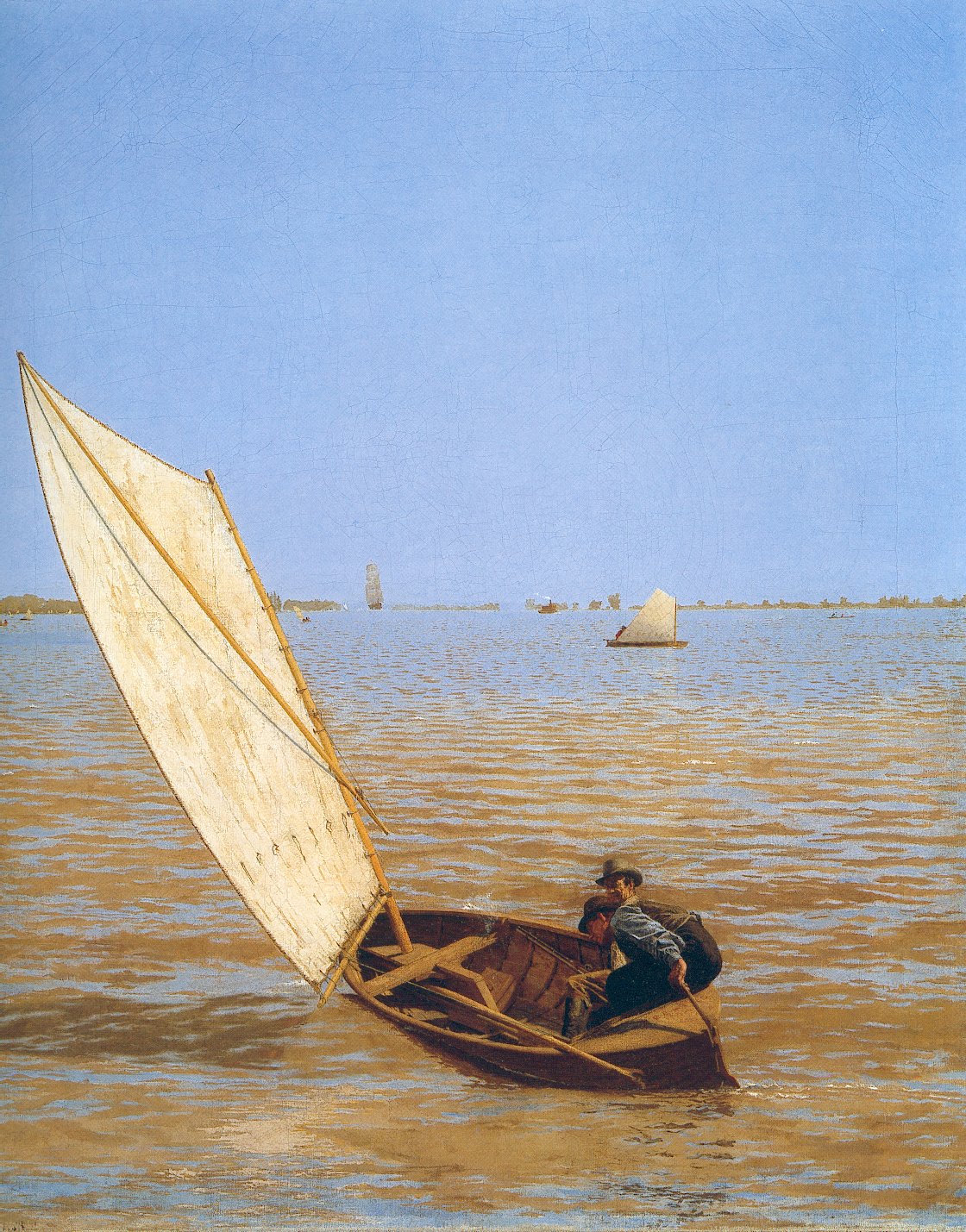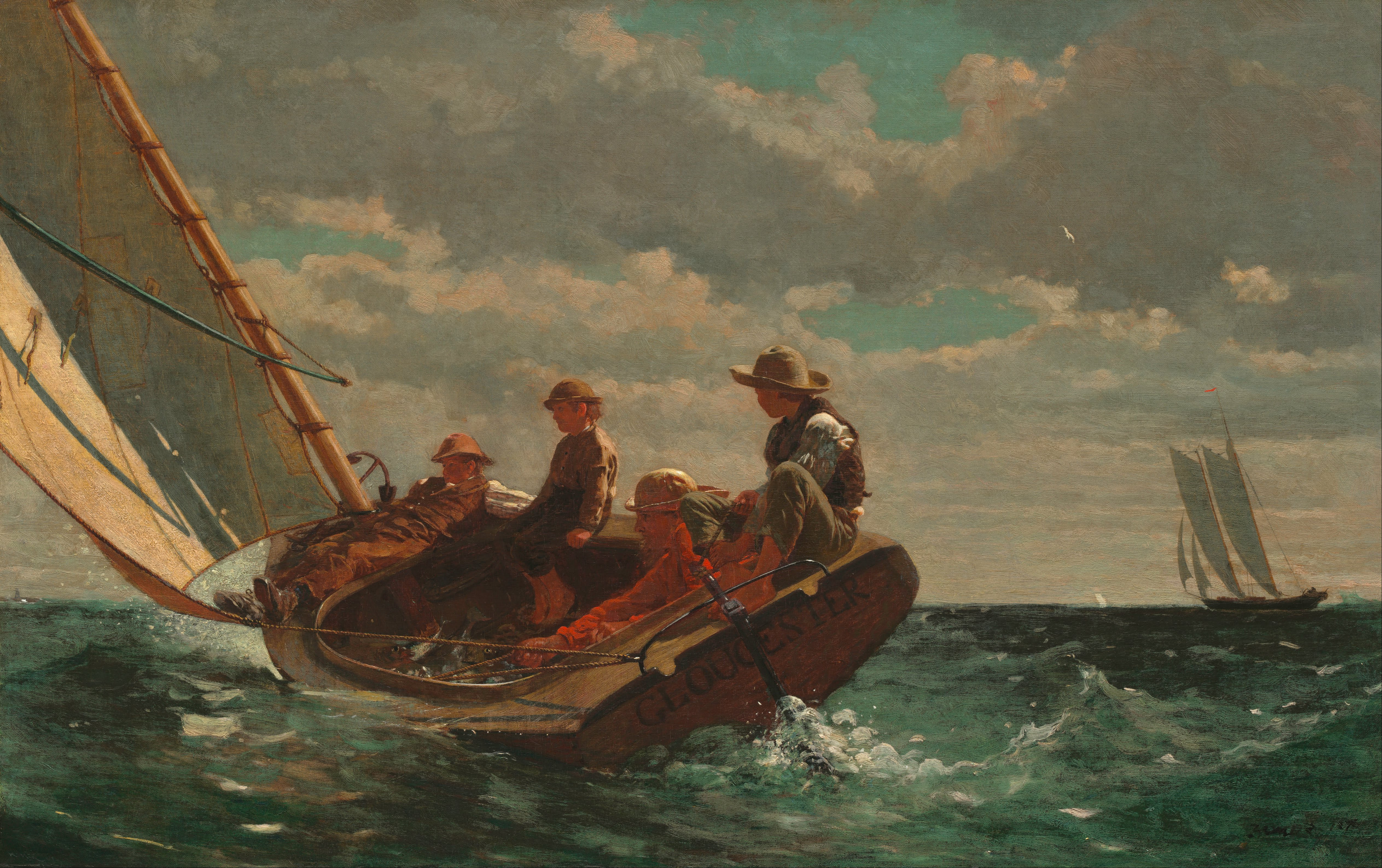Ground Swell on:
[Wikipedia]
[Google]
[Amazon]
''Ground Swell'' is a 1939 painting by American artist Edward Hopper which depicts five people on a heeling

 The painting depicts a group of young people in a boat caught in the titular ocean swell. The bright sunlit exhibits Hopper's enthusiasm for the sea, which can also be found in his other nautical paintings and seascapes – most notably his paintings of
The painting depicts a group of young people in a boat caught in the titular ocean swell. The bright sunlit exhibits Hopper's enthusiasm for the sea, which can also be found in his other nautical paintings and seascapes – most notably his paintings of
catboat
A catboat (alternate spelling: cat boat) is a sailboat with a single sail on a single mast set well forward in the bow of a very beamy and (usually) shallow draft hull. Typically they are gaff rigged, though Bermuda rig is also used. Most are f ...
in a light swell, looking at an ominous buoy. It was in the collection of the Corcoran Gallery of Art
The Corcoran Gallery of Art was an art museum in Washington, D.C., United States, that is now the location of the Corcoran School of the Arts and Design, a part of the George Washington University.
Overview
The Corcoran School of the Arts & Design ...
from 1943 until it was purchased by the National Gallery of Art
The National Gallery of Art, and its attached Sculpture Garden, is a national art museum in Washington, D.C., United States, located on the National Mall, between 3rd and 9th Streets, at Constitution Avenue NW. Open to the public and free of char ...
in Washington, D.C.
)
, image_skyline =
, image_caption = Clockwise from top left: the Washington Monument and Lincoln Memorial on the National Mall, United States Capitol, Logan Circle, Jefferson Memorial, White House, Adams Morgan, ...
in 2014.
Several preparatory studies are held by the Whitney Museum of American Art
The Whitney Museum of American Art, known informally as "The Whitney", is an art museum in the Meatpacking District and West Village neighborhoods of Manhattan in New York City. It was founded in 1930 by Gertrude Vanderbilt Whitney (1875–1942), ...
in New York City
New York, often called New York City or NYC, is the List of United States cities by population, most populous city in the United States. With a 2020 population of 8,804,190 distributed over , New York City is also the L ...
.
Description

 The painting depicts a group of young people in a boat caught in the titular ocean swell. The bright sunlit exhibits Hopper's enthusiasm for the sea, which can also be found in his other nautical paintings and seascapes – most notably his paintings of
The painting depicts a group of young people in a boat caught in the titular ocean swell. The bright sunlit exhibits Hopper's enthusiasm for the sea, which can also be found in his other nautical paintings and seascapes – most notably his paintings of New England
New England is a region comprising six states in the Northeastern United States: Connecticut, Maine, Massachusetts, New Hampshire, Rhode Island, and Vermont. It is bordered by the state of New York to the west and by the Canadian provinces ...
lighthouse
A lighthouse is a tower, building, or other type of physical structure designed to emit light from a system of lamps and lenses and to serve as a beacon for navigational aid, for maritime pilots at sea or on inland waterways.
Lighthouses mar ...
s such as ''Lighthouse Hill'' (1927) and ''The Long Leg'' (1930). However, a sense of isolation pervades all of these paintings. In ''Ground Swell'' specifically, the loneliness of the boat and the rather ominous presence of a buoy
A buoy () is a floating device that can have many purposes. It can be anchored (stationary) or allowed to drift with ocean currents.
Types
Navigational buoys
* Race course marker buoys are used for buoy racing, the most prevalent form of yac ...
signify themes of impending doom. National Gallery of Art curator Adam Greenhalgh writes that the painting possibly references the beginning of World War II
World War II or the Second World War, often abbreviated as WWII or WW2, was a world war that lasted from 1939 to 1945. It involved the vast majority of the world's countries—including all of the great powers—forming two opposin ...
, which occurred while Hopper was working on ''Ground Swell''.
The boat is sailing on a sunlit sea, with three passengers, two men and a woman, and another man at the tiller
A tiller or till is a lever used to steer a vehicle. The mechanism is primarily used in watercraft, where it is attached to an outboard motor, rudder post or stock to provide leverage in the form of torque for the helmsman to turn the rudder. ...
. The men are topless, with long white slacks; the woman wears a red kerchief over her hair, and a red halter top with dark slacks. The people pay no attention to each other as they are all focused on an ominous bell buoy bobbing on the rolling waves. The blue-green buoy with brown seaweed is the only dark feature in a scene dominated by bright blues and whites, its clanging bell warning of imminent but hidden dangers. Cirrus clouds in the sky herald an approaching storm hinted by the dark line of the horizon, perhaps influenced by Hopper's experience during the 1938 New England hurricane
The 1938 New England Hurricane (also referred to as the Great New England Hurricane and the Long Island Express Hurricane) was one of the deadliest and most destructive tropical cyclones to strike Long Island, New York, and New England. The stor ...
the previous year.
The composition, with a heeling catboat
A catboat (alternate spelling: cat boat) is a sailboat with a single sail on a single mast set well forward in the bow of a very beamy and (usually) shallow draft hull. Typically they are gaff rigged, though Bermuda rig is also used. Most are f ...
, is similar to Thomas Eakins's 1874 '' Starting Out after Rail'' and Winslow Homer's 1873–1876 ''Breezing Up (A Fair Wind)
''Breezing Up (A Fair Wind)'' is an oil painting by American artist Winslow Homer. It depicts a catboat called the ''Gloucester'' chopping through that city's harbor under "a fair wind" (Homer's original title). Inside the boat are a man, three b ...
''. Homer's painting was made a few years after the end of the American Civil War
The American Civil War (April 12, 1861 – May 26, 1865; also known by other names) was a civil war in the United States. It was fought between the Union ("the North") and the Confederacy ("the South"), the latter formed by states th ...
, with the crew of the boat optimistically looking to the horizon: in Hopper's work, the scene of tranquility contains notes of peril.
Before executing ''Ground Swell'', Hopper made a number of preparatory studies, some of which are now in the Whitney Museum of American Art
The Whitney Museum of American Art, known informally as "The Whitney", is an art museum in the Meatpacking District and West Village neighborhoods of Manhattan in New York City. It was founded in 1930 by Gertrude Vanderbilt Whitney (1875–1942), ...
. Compositionally, the sketches are the same, but Whitney museum curator Carter Foster notes that there were small variations between the sketches, such as cropping and level of detail, that were synthesized in the final work.
Hopper used a medium-weight plain-weave "Winton" canvas, with a grain that makes it suitable for landscapes and seascapes, commercially pre-primed with a thin layer of cream paint. Graphite squaring-off lines suggest it was scaled up from an earlier drawing or photograph. The paint is applied thinly in many areas, but the sea is painted with many thick layers through which Hopper dragging his brush, and the white sail was thickly applied with a palette knife. The rigging was added in graphite pencil.
Provenance
Hopper painted the work at his studio in Truro, Massachusetts, in August and September 1939. His daybook records he completed it on September 15, 1939. The completed work was exhibited at the Eighteenth Biennial Exhibition of Contemporary American Oil Paintings at theCorcoran Gallery of Art
The Corcoran Gallery of Art was an art museum in Washington, D.C., United States, that is now the location of the Corcoran School of the Arts and Design, a part of the George Washington University.
Overview
The Corcoran School of the Arts & Design ...
in 1943, for which Hopper was a juror. It was acquired from the exhibition by the Corcoran Gallery of Art, and remained at the Corcoran Gallery until it was dissolved. In 2014, ''Ground Swell'' was purchased by the National Gallery of Art
The National Gallery of Art, and its attached Sculpture Garden, is a national art museum in Washington, D.C., United States, located on the National Mall, between 3rd and 9th Streets, at Constitution Avenue NW. Open to the public and free of char ...
with the William A. Clark fund. The painting is currently part of the National Gallery's Corcoran Collection.
Legacy
Hopper's painting became the subject of a lecture and an article byStanford University
Stanford University, officially Leland Stanford Junior University, is a private research university in Stanford, California. The campus occupies , among the largest in the United States, and enrolls over 17,000 students. Stanford is consider ...
professor Alexander Nemerov
Alexander Nemerov (born 1963) is the Carl and Marilyn Thoma Provostial Professor in the Arts and Humanities as well as Chair of the Department of Art and Art History at Stanford University. He was previously a Professor of Art History and Ameri ...
, both titled ''Ground Swell: Edward Hopper in 1939''. In the lecture and the article, Nemerov examines ''Ground Swells connections with the political and cultural events of 1939, as well as the personal significance of the painting for Hopper. Nemerov's lecture was held in 2007 with funding from the Wyeth Foundation for American Art, while the article was featured in the 2008 fall volume of the journal ''American Art
Visual art of the United States or American art is visual art made in the United States or by U.S. artists. Before colonization there were many flourishing traditions of Native American art, and where the Spanish colonized Spanish Colonial arc ...
''.
References
{{Edward Hopper 1939 paintings Paintings by Edward Hopper Maritime paintings Collections of the National Gallery of Art